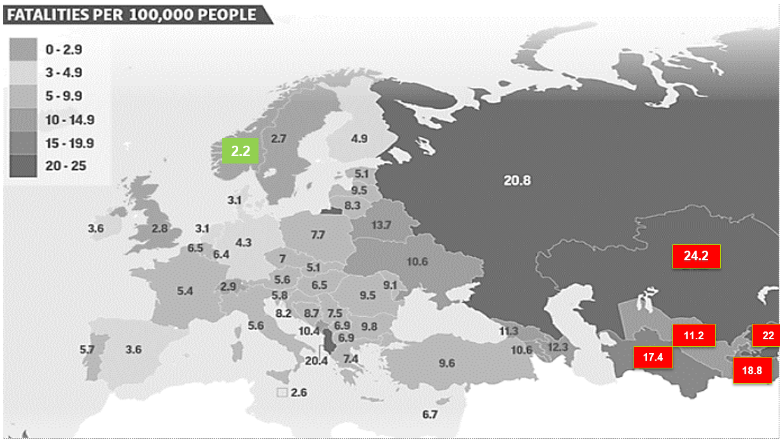Do you know that in Kazakhstan we live in the country with the deadliest roads? Every year, 3,000 people die on roads in Kazakhstan, and over 30,000 are injured. Imagine if an airplane crashed every month! Would you fly?
We are 11 times more likely to die in a traffic accident in Kazakhstan than in Norway. Indeed, the numbers for road deaths are high in all Central Asian countries.

Globally, road traffic injuries are the leading cause of death among people aged between 15 and 29 years. Not cancer, not heart diseases, and not wars.
Life changing injuries and deaths affect countries in terms of health care and economic costs – the annual economic loss of road deaths in Central Asian countries is estimated at around 3-4% of GDP.
But, beyond this monetary value, lies a person’s life.
In two-thirds of cases, the victim is a young man aged between 18-44, who is also the main breadwinner of the family. After the loss, there is a chance that the kids will need to drop out of school or university and start working to support their families. In most cases, they will have to give up their dreams of a better life. The government, in turn, will have to increase subsidies to support yet another family – around 1,645 USD annually for each family without a breadwinner in Kazakhstan.
The question I often ask my counterparts in the government is, "What is the figure the government should be targeting in terms of reduction in the number of accidents and deaths on the road? You are here now: 24 fatalities per 100,000 people. Where do you want to be five years from now?"
The answer usually varies from 10% to 70%. Then I ask: now let's imagine this is your family. Are you ready to lose this percentage of your family during the next five years? The answer is no. Always No. People want zero fatalities in their families. Now and tomorrow.
And – as international experience shows - this can be done. Sweden, Norway, and Eastern European countries did it. Sweden first started the “vision ZERO” national safety program, which aimed at achieving ZERO deaths or serious injuries on roads.
By investing in understanding the problem, getting the data and taking actions based on it, coordinating with multiple agencies and sectors within the government, and building effective legislation – this initiative became a success.
We at the World Bank are supporting countries in a number of ways. In Kazakhstan, for example, as part of the East West Roads Project, the design of road sections connecting Balkhash to Burylbaital were analyzed based on the I-RAP method and critical areas for improvements were identified to make them safer. As experience shows, even simple low-cost engineering measures can save thousands of lives. In the South West Roads Project, fifteen local road professionals were trained to conduct Road Safety Audit and Inspection at various stages – design, civil works implementation, and opening of the road.
To fight road injuries and deaths, one should know the data, measure it, and take persistent actions to improve it. Therefore, under the East West Roads Project, we are also supporting the government in deploying a system for geo-spatial recording and analyzing road crashes.
The World Bank’s web-based and open-source platform DRIVER (the Data for Road Incident Visualization Evaluation and Reporting system) is already available in multiple languages and has been tested in several countries in Asia and Latin America.
Experience shows that the role of the government is the most critical one in making the changes, supporting innovation, and ensuring sustainability. Since road safety actions should address safety of roads, vehicles, and road users, many government institutions - transport, police, health, education – need to be involved in a coordinated manner.
In a recently published report, The High Toll of Traffic Injuries, we provide more examples of proven and promising road safety interventions implemented around the globe that saved and secured healthier lives for people.
While a lot has been achieved in Kazakhstan and Central Asian road safety lately, there is still a lot to strive for. We have to mobilize our efforts on many fronts and urgently - since every day can become either a tragedy or a celebration of life.
And we all prefer celebrations.


Join the Conversation